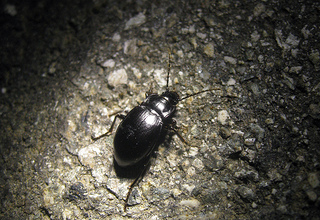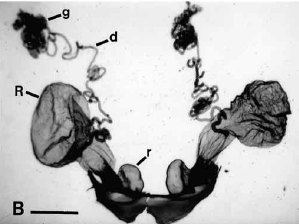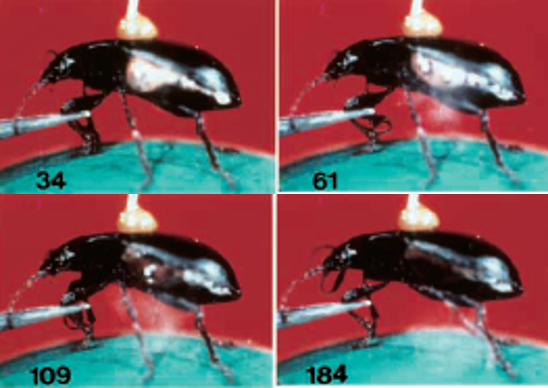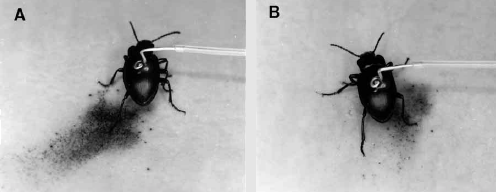Form and Function
The simple exterior appearance of Metrius contractus is truly
rather deceiving.
 At a glance they are quite similar to other
closely related bombardier beetles and
only generally develop to be a mere two centimeters long (μMist
spray technology 2013). Like other arthropods, they have a protective
exoskeleton of
chitin, multiple jointed legs, and wings (Eisner and Meinwald
1995).
If bombardier beetles all have wings, why don’t they just fly
away when attacked? Unlike some other arthropods such as
Horseflies and
The Bald-faced Hornet, they are not quite
masters of flight. According to Dr. Schwarcz of the Chemical
Institute of Canada, bombardier beetles do not have their wings
out and readily available for use like other arthropods. They
have covers over their wings that need to be moved before flight
can be initiated (Schwarcz 2010). Bombardier beetles are also
generally rather slow moving creatures and cannot dart away when
experiencing unfavorable interactions (Eisner
et al. 1977).
At a glance they are quite similar to other
closely related bombardier beetles and
only generally develop to be a mere two centimeters long (μMist
spray technology 2013). Like other arthropods, they have a protective
exoskeleton of
chitin, multiple jointed legs, and wings (Eisner and Meinwald
1995).
If bombardier beetles all have wings, why don’t they just fly
away when attacked? Unlike some other arthropods such as
Horseflies and
The Bald-faced Hornet, they are not quite
masters of flight. According to Dr. Schwarcz of the Chemical
Institute of Canada, bombardier beetles do not have their wings
out and readily available for use like other arthropods. They
have covers over their wings that need to be moved before flight
can be initiated (Schwarcz 2010). Bombardier beetles are also
generally rather slow moving creatures and cannot dart away when
experiencing unfavorable interactions (Eisner
et al. 1977).
Because they cannot simply fly away or swiftly run when approached by a frightening predator, evolution had
to give
bombardier beetles a different plan for defense in order for
them to survive as long as they have. Fully efficient
chemistry laboratories completely stocked with
every needed reagent have been developed inside of the abdomens
of bombardier beetles (James et al. 2012). Nature certainly has
other chemistry master organisms like
Stinging Nettles and
The Kiss Me Quick Plant, but there is nothing quite like the tiny
potent bombs inside of bombardier beetles. Metrius contractus in
particular withholds quite intensive and unique chemistry inside
of its reaction chambers (Eisner et al. 2000).
long as they have. Fully efficient
chemistry laboratories completely stocked with
every needed reagent have been developed inside of the abdomens
of bombardier beetles (James et al. 2012). Nature certainly has
other chemistry master organisms like
Stinging Nettles and
The Kiss Me Quick Plant, but there is nothing quite like the tiny
potent bombs inside of bombardier beetles. Metrius contractus in
particular withholds quite intensive and unique chemistry inside
of its reaction chambers (Eisner et al. 2000).
Before the actual process and function of the jet system is
discussed, it is worth noting the fortress of physiology it
takes to contain such powerful chemical reactions. The reason
the beetle does not bring harm to itself in producing explosive
mists of toxin up to 100°C is due to its superb structure
(Beheshti and McIntosh 2007).
Posterior quarters of bombardier
beetles are compartmentalized into a
reservoir or storage
chamber for holding unreacted chemicals and a
reaction chamber
with numerous
enzymes that are able to quickl y catalyze the
formation of the toxic spray when necessary (Eisner et al.
2000). There are two sets of these
chambers, one on both the left and right side of the beetle
(Beheshti and McIntosh 2007). A valve attached to a muscle
connects the two chambers preventing the reaction from occurring
when unnecessary so that futile reactions do not consume energy
and resources (Beheshti and McIntosh 2007). Observe the image to
the right displaying these structures where letters R, r, d, and
g correspond to the reservoir, reaction chamber,
efferent duct, and
gland respectively. The tissues making
up both of these chambers contain a
cuticle layer for
protection, but the storage chamber has much thinner more
flexible walls (Eisner et al. 2000). This can largely be
attributed to the fact that an extremely powerful
oxidation
happens in the reaction chamber which requires it to be thicker and
more rigid to protect the rest of the body (Eisner et al.
2000). Small glands are also imbedded in the walls of the
reaction chamber that release the enzymes for the reaction
(Beheshti and McIntosh 2007).
y catalyze the
formation of the toxic spray when necessary (Eisner et al.
2000). There are two sets of these
chambers, one on both the left and right side of the beetle
(Beheshti and McIntosh 2007). A valve attached to a muscle
connects the two chambers preventing the reaction from occurring
when unnecessary so that futile reactions do not consume energy
and resources (Beheshti and McIntosh 2007). Observe the image to
the right displaying these structures where letters R, r, d, and
g correspond to the reservoir, reaction chamber,
efferent duct, and
gland respectively. The tissues making
up both of these chambers contain a
cuticle layer for
protection, but the storage chamber has much thinner more
flexible walls (Eisner et al. 2000). This can largely be
attributed to the fact that an extremely powerful
oxidation
happens in the reaction chamber which requires it to be thicker and
more rigid to protect the rest of the body (Eisner et al.
2000). Small glands are also imbedded in the walls of the
reaction chamber that release the enzymes for the reaction
(Beheshti and McIntosh 2007).
Aside from the
astounding chemical reaction system, the overall abdomen of
bombardier beetles is also strategically structured for
efficiency (Agosta 1996). An experiment run by Eisner et al.
(2000) tested the ability of bombardier beetles and specifically
Metrius contractus to aim their jets to hit threats.
By using indicator paper and irritating the beetles from
different positions, they were able to determine that the
beetles were able to use their flexible abdomen to aim their sprays
quite accurately. Overall, the efficiency of bombardier beetles arises from
amazing structure and impressive
chemistry. The functions that
allow for form and chemistry to work together are remarkable. The functions of
Metrius contractus certainly relate
to its
interactions and
habitat, but its most
relevant and unique functional activity is with its jets.
As
seen in work by Agosta, when alarmed, bombardier beetles open
the valve connecting the reaction chamber and the storage
chamber thereby releasing powerful chemicals to be catalyzed by
enzymes. Almost instantly, an oxidation reaction occurs
resulting in intense heat and toxic products (Agosta 1996).
Reactants are prevented from flowing backwards by the muscle and
valve in the connecting channel which shuts tightly due to
pressure from the reaction (James et al. 2012). The heat and
pressure produced in this reaction then force the toxin out of
the tip of the beetle’s abdomen (Agosta 1996). The immense power
behind this bombarding chemistry is so forceful that it actually
makes a fairly audible sound as it bursts forth in defense
(Schwarcz 2010).
While Metrius contractus is mostly extremely similar to other
bombardier beetles, its form and function have several key
differences. These differences are essential in the
determination of its evolutionary classification (Eisner et al.
2000). Most bombardier bee tles eject their spray in a harsh
streamline fashion (Beheshti and McIntosh 2007). Metrius
contractus creates more of a mist by puffing out its spray as
an oozing chemical (Eisner et al. 2000). This alternate way of
excretion gives insight into how more ancient bombardier beetles
probably functioned and actually serves as a benefit to Metrius
contractus (Eisner et al. 2000). Metrius contractus remains in a
cloud of its spray for quite awhile so that its enemies don’t
try to attack again (Eisner et al. 2000). Other very enthralling
factoids of the pure uniqueness of Metrius contractus are
heavily related to the
chemistry intricately guiding its ability
to defend itself (Eisner et al. 1977).
tles eject their spray in a harsh
streamline fashion (Beheshti and McIntosh 2007). Metrius
contractus creates more of a mist by puffing out its spray as
an oozing chemical (Eisner et al. 2000). This alternate way of
excretion gives insight into how more ancient bombardier beetles
probably functioned and actually serves as a benefit to Metrius
contractus (Eisner et al. 2000). Metrius contractus remains in a
cloud of its spray for quite awhile so that its enemies don’t
try to attack again (Eisner et al. 2000). Other very enthralling
factoids of the pure uniqueness of Metrius contractus are
heavily related to the
chemistry intricately guiding its ability
to defend itself (Eisner et al. 1977).
Revisit Habitat, Geography, & Interactions or move on to Reproduction.

